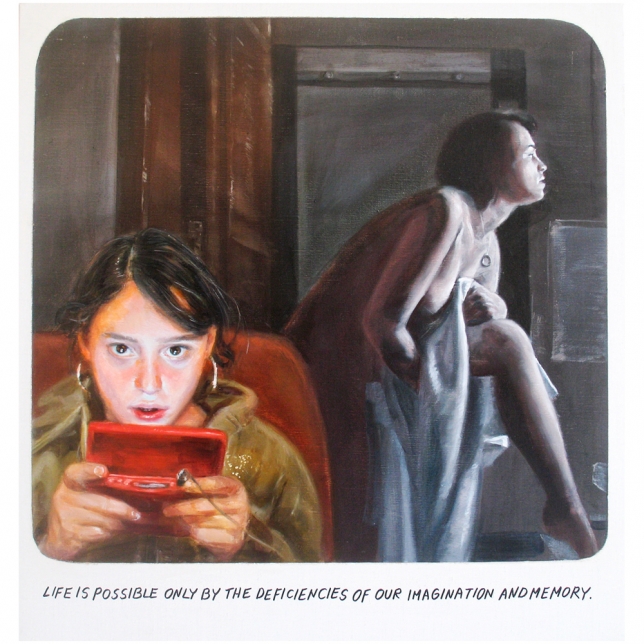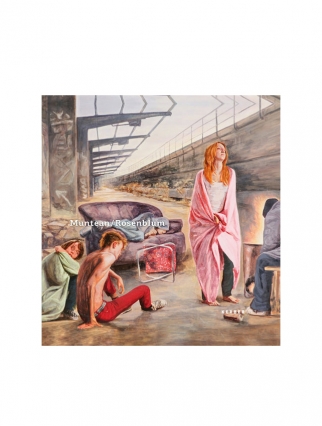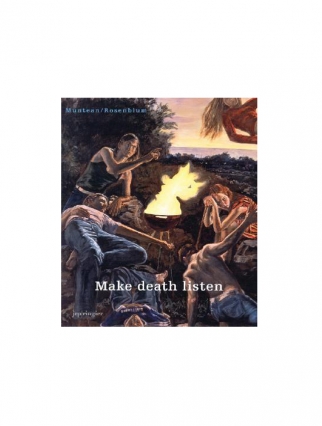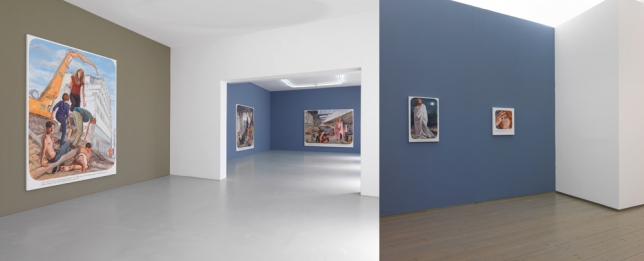03.05. – 07.06.2008
Muntean / Rosenblum
Solo exhibition at Arndt & Partner, Berlin
Muntean/Rosenblum
Adi Rosenblum was born in 1962 in Haifa, Israel
Markus Muntean was born in 1962 in Graz, Austria
They live and work in collaboration in Vienna and London.
The works of Muntean/Rosenblum often refer to traditional formulas of expression, in order to represent certain emotions. By transferring representational conventions to their own work, they succeed in disclosing how -throughout history- the meaning of a certain gesture may change into it’s contrary. In one of Muntean/Rosenblum’s works for example, the lasciviously bending gesture of a male adolescent characterized by lethargy and boredom is reminiscent of traditional representations of Christ’s removal from the cross or depictions of martyr. Despite the artists’ rather specific handwriting, they employ a wide range of formal approaches: Besides their widely recognized works on canvas as well as their drawings, Muntean/Rosenblum also present their remix of art history and contemporary society in the media film and installation.
The artist duo has staged solo shows in renowned institutions such as Essl Museum – Contemporary Art, Klosterneuburg, Austria (2008), Galerie für Zeitgenössische Kunst, Leipzig, Germany (2007), MUSAC, León, Spain (2006), Tate Britain, London (2004), and the Australian Centre for Contemporary Art, Melbourne (2004). They participated in significant international group exhibitions such as “Rewind/Fast Forward,” Neue Galerie, Graz, Austria (2009), “Friendly Enemies,” Galerie für Zeitgenössische Kunst, Leipzig, Germany (2008), “Wann immer vorerst,” BA-CA Kunstforum, Vienna (2007), “The Triumph of Painting” and “New Blood,” both at Saatchi Gallery, London (2006 and 2005), and the 26th São Paulo Biennial (2004). In Berlin they gained wider recognition through their installation “Where else,” shown at the 2nd Berlin Biennial (2001), followed by their solo show at Arndt & Partner (2005 and 2008).
29.4. - 30.5.2010
“Changing The World”
Group exhibition at ARNDT, Berlin
03.05. – 07.06.2008
Muntean/Rosenblum
Solo exhibition at Arndt & Partner, Berlin
12.05. – 23.06.2007
The Aggression of Beauty II
Group exhibition at Arndt & Partner, Berlin
20.05. – 03.06.2006
Muntean/ Rosenblum
Solo exhibition at Arndt & Partner, Zurich
15.10. – 20.11.2005
“Works on paper”
Group exhibition at Arndt & Partner, Berlin
19.03. – 30.04.2005
Muntean / Rosenblum
“Far away from why“
Solo exhibtion at Arndt & Partner, Berlin
 Muntean/Rosenblum, Life is possible only by..., 2010, 2010, oil on canvas, 54 x 51 cm | 21.26 x 20.08 in, MUNT0183
Muntean/Rosenblum, Life is possible only by..., 2010, 2010, oil on canvas, 54 x 51 cm | 21.26 x 20.08 in, MUNT0183 Publications: Muntean / Rosenblum
This book was published on occasion of a solo exhibition of Muntean/Rosenblum at Arndt & Partner, Berlin, 2008.
Publisher: Kerber Verlag, Bielefeld, 2008
Language: English / German
Hardcover
84 pages, many colour plates
With contributions by Mark Gisbourne und Abraham Orden
ISBN: 978-3-86678-167-2
Price 28 €
Publication: Muntean/Rosenblum: Make Death Listen
Published by JRP Editions in cooperation with MUSAC, Museo de Arte Contemporáneo de Castilla y Léon.
Contributions by Augustin Perez Rubio, Barbara Steiner and Andrew Renton
182 pages, 130 in colour
Language: English or Spanish
Published with the support of Arndt & Partner Berlin/Zurich
ISBN-10: 3905701987
ISBN-13: 978-3905701982
Exhibitions
PRESS RELEASE
Arndt & Partner Berlin is delighted to present the third solo show with works by Muntean/Rosenblum. On occasion of the Berlin Gallery Weekend the exhibition will be taking place over both floors.
Muntean/Rosenblum’s compositional approach to painting is traditional, though as much derived from the collective memory of figuration in popular media (fashion magazines) as it is from the direct appropriations from Renaissance, Baroque, and Neo-Classical motifs. Presented as tableaux of adolescent life, the images are always lozenge-like with a surrounding border of white. In visual terms they are not without similarity to an old-fashioned television set or popular comic images. Written in a hand-script is an accompanying maxim, aphorism, or expressive comment, though it is never directly connected to a particular figure within the image. The texts are emblematic, and form a deliberately ambiguous or liminal content. This is to say they form a threshold in which they are neither explicitly related to the image, but nor are they not related to the painting. The adolescent boys and girls are most often static and gripped with a sense of lassitude. They are young and invariably attractive, but any easily readable psychological content is denied to the viewer. The subject matter constantly slips away from the viewer, and though we recognise these young people through their trendy clothes, their trainers, and their familiar bourgeois lifestyle and material acquisitions, it does not immediately open up any sense and/or wish for a personal identification.
While my analysis might suggest a sombre or negative tone, they are extraordinary images in every other respect. Muntean/Rosenblum show the problematic nature of figurative painting today. In what they refer to as a polyphonic structure, they create a system of precise ambiguity with each element being knowingly self-referential and simultaneously self-critical "one of the main issues is the contemporary notion of the subject and the question of identity." Hence their analysis and investigation of the use of the figurative poses and gestures in painting today, is something of a modern Iconologia.
If we consider Muntean/Rosenblum's pseudo-taxonomic photographs of adolescents (not unlike those Thomas Ruff), with their set poses and repetitions (another important thematic in the artist's works), we find that their ambivalent symbolic translations into paintings is a deliberate act of idealisation – further stressing the subject or sitter's general anonymity and lack of identity. These young would-be sitters are thus appropriated as types, further emphasised as they wear T-Shirt designs painted by the artists. There are no scars or blemishes on these beautiful young people, no violence or overt truculence expressed towards each other, nothing squalid that affirms what is often the natural circumstance and visible reality of the world. The passive figures are made invariably tall, slim and elongated, which indicates they are more about the conventions of painting than merely recognition or storytelling. The figures are not focused on description so much as on their being typological entities – only their material belongings take on a sense of being an identifiable brand. Hence there is no determined line of reading to follow, and in this sense they depart from the conventional notion of the pattern book – they are not prescriptive.
In a paradoxical sense, Muntean/Rosenblum are addressing in painting the opposite of what they appear to portend (a life event), and are able in and through their chosen characters state of general ennui, to show their subjects indexical sense of loss – the adolescent search for meaning and identity. The artist's use of adolescence and youth as a syntactical trope not only reveals the seemingly pessimistic reality of these young lives, but points in a wider sense to the contemporary condition of the world today. A Western world where all forms of secure identity are in a state of continual slippage, as we increasingly experience or abandon ourselves to a state of virtual existence.
In a whole series of recent paintings like there is a decisive shift in formal terms. Rather than their earlier frieze-like presentation there is greater compositional gesture and posed complexity. This is evident in a landscape setting such as Untitled (It was as though...), (2006), where we feel we are looking at a compositional stage set – a Baroque or operatic theatre performance conveyed through the visual relocation into contemporary dress. It is a theatre of compositional interrelations, the foreshortened youth with his arms outstretched forming an arc of inclusion with the cowboy-like figure holding a rifle and seated centre left. The yellow blanket with its V-inverted drapery folds, almost identical with those invented in fourteenth and fifteenth century Florentine painting.
Paradoxically, perhaps, among the most striking achievements of Muntean/Rosenblum, is their ability to have fundamentally digested and elided former distinctions between abstraction and figuration. If modernism set the two positions apart, indeed, created an arbitrary dichotomy between abstraction and figuration, transposing Muntean/Rosenblum's figurative compositions into abstract block relations can be achieved instantaneously in the mind of the viewer. Their paintings seem to suggest they are less about subject matter, than the matter of painting suborned by a subject that merely reinforces their reality as paintings. The artists seem to be saying that contemporary figure painting (as painting) has become something of an echo, a shifting ground that is never certain and/or perpetually indeterminate. Hence their works are not literal paintings of contemporary life in the modernist sense of the tradition instituted by Edouard Manet, and they do not attempt to transcend history painting so much as expose to view its fragile (sometimes facile) and eternally repeatable vocabulary. If they are laments, they are the lamentations of human emptiness, the isolated mantra of an eternal return or incessant repetition. In short the most common commodity of our everyday lives, but particularly so among a youth culture with promised expectations which are easily suffused into an ennui of lassitude and disappointment.
Excerpt from “Double act : two artists, one expression” by Mark Gisbourne, edited by Ulf Meyer zu Küingdorf, Munich, New York: Prestel, 2007. A comprehensive catalogue will be published to accompany the exhibition.
20.05. – 03.06.2006
Muntean/Rosenblum
solo exhibition at Arndt & Partner, Zurich
PRESS RELEASE
With a solo exhibition of artist couple Muntean/Rosenblum at Arndt & Partner Zurich, Arndt & Partner are pleased to continue a successful cooperation that commenced at Arndt & Partner Berlin in 2004.
The works of Muntean/Rosenblum stage teenagers, whose blank facial expressions reveal, that they have learned to embody the stereotypical idea of beauty and of society, imposed on them by mass media. They are the products of a media society, they have understood the message of the advertising industry, nonetheless they are consciously or unconsciously longing for much more, as implicated by the "sub-titles" in the paintings. Precisely this yearning for security and approval, for affection and for a fulfilling goal of life makes the characters inter-changeable. Even though they are striving for individuality and uniqueness, the attempts repeatedly result in the convertibility of mass society, because they are oriented towards the same idols and patterns.
"The flood of images of the perfect body negates the real body and we want to make it visible again, in its entire mortality", says Markus Muntean. "An individual coming-of-age novel no longer exists that one may inscribe one's ego somewhere and take time to develop oneself".
The works of Muntean/Rosenblum focus on kinds of depiction, that are art-historically regarded as traditional formulas of Pathos. Muntean/Rosenblum broach the issue of mixing aesthetics and existence. If for Aby Warburg the meaning of a formula of Pathos rests primarily on its function as a symbolic pictorial code for researching the tradition of depiction, in Muntean/Rosenblum's work it can be understood as part of a physical self-concept and the construction of individuality and collectiveness. (Cosima Rainer in "There Is A Silence to Fill", exhibition catalogue Kunstverein Salzburg, 2003)
Muntean/Rosenblum give expression to their thus defined subject matters in many ways: besides their widely recognized works on canvas and their drawings, Muntean/Rosenblum further present their remix of art history and contemporary society in the media film and installation. Rarely, a theme has been discussed with such stringency, while exploring such a diverse range of different media.
"We are interested in cultural memory rather than phenomena of Zeitgeist. Our worlds are often read understood in the context of youth culture, but that is only one aspect of the work that is not predominant."
It is characteristic for the working method of the artists that a figurative composition is combined with a "sub-title" in capital letters on a white background. As a result the works shifts towards abstraction and the fragmentary qualities of the images are treated with irony. The seemingly deep, philosophical statements are assembled from excerpts taken from various magazines and philosophical texts.
The video work "Disco"(2005), presented adjacent to paintings and drawings in the exhibition, demonstrates a new interpretation of Théodore Gericault's painting "The Raft of the Medusa" from 1818/19. The painting illustrates the dramatic moment of rescue of a number of shipwrecked of the "Medusa", who had been drifting on the open sea on an odyssey of several weeks lacking water and food. In slow, quiet recordings the artists generate scenes resembling Tableau Vivants of the 19th century. In case of "Disco", the preceding, invisible catastrophe had happened under a mirror ball on the dance floor of a club. Like in Gericault's composition the muscular bodies of the survivors pile up in a dynamic triangular composition on the steps to the dance floor, culminating in a standard bearer calling for attention with help of a white flag. Arias from an Händel opera atmospherically accompany with the scene. A young girl that had been seen dressed as a cleaner before turns into a weeping saint appearing to mourn over the fate of the salvaged.
The Austrian Markus Muntean and Israeli Adi Rosenblum have been collaborating under the label Muntean/Rosenblum since 1992. They live and work in London and Vienna.
This autumn the MUSAC, Museo de Arte contemporaneo de Castilla y Lèon, Spain, will present their work in a comprehensive solo exhibition and in 2007 their work will be shown in a solo show at Galerie für Zeitgenössische Kunst in Leipzig. Their exhibition history of the past years comprises solo exhibitions in renowned museums: in 2005 the artists were on show in solo presentations in London, San Francisco, Berlin and Vienna. In 2004, Tate Britain, London, and the Australian Centre for Contemporary Art, Melbourne, dedicated large solo exhibitions to them. In 2004 alone, the list of group exhibitions they participated in, includes the Sao Paolo Biennale, the Saatchi Gallery, London, the Museum für Angewandte Kunst, Vienna, as well as the Museum für Fotografie, Braunschweig, Germany.
19.03. – 30.04.2005
Muntean / Rosenblum
“Far away from why“
Solo exhibition at Arndt & Partner, Berlin
PRESS RELEASE
With the solo exibition of the London-based collective Muntean / Rosenblum Arndt & Partner, are delighted to announce the inclusion of this significant position of contemporary art into the gallery program.
Below a group portrait of six teenagers a text in capitols reads: "We wereboth surprised and touched but could hardly express any emotion, because somehow, having left behind the pain in contemplation, so little of us was there, to be pondered on or grasped". Is this really a thought of one of the potrayed? Or is this rather a quote that has been layed into the mouths of those upon first sight carefree looking young people? The words seem to impede and at the same time to replenish them with a depth, of which the youngsters do not yet seem conscious of.
The works of Muntean / Rosenblum persistently confront us with people, whose appearances disclose them as children of our times. They are wearing up-to-date clothes, they are young, handsome, and seemingly adapted to our society. Yet, in a peculiar way they seem out of place. The vacant look in their eyes reveals that they have learned to embody the stereotypical image of youth reproduced by mass media. They are the products of a society marked by MTV and they have adapted the message of the advertisement industry well.
At the same time, the written text in the paintings implicate that the portrayed persons are consciously or unconsciouly longing for so much more. It is precisely this yearning for security and respect, for affection and for a fullfilling goal of life one reads in their facial expressions, that creates this unmistakable presence of all of Muntean / Rosenblum's characters. The protagonist's isolation, which they chose themselves, but which they are not responsible for, hinders them from seeing their own dreams come true.
The works of Muntean / Rosenblum often refer to traditional formulas of expression, in order to represent certain emotions. By transferring representational conventions to their own work, they succeed in disclosing how - throughout history - the meaning of a certain gesture may change into it's contrary. In one of Muntean / Rosenblum's works for example, the lasciviously bending gesture of a male adolescent characterized by lethargy and boredom is reminiscent of traditional representations of Christ's removal from the cross or depictions of martyr. Despite the artists' rather specific handwriting, they employ a wide range of formal approaches: Besides their widely recognized works on canvas as well as their drawings, Muntean / Rosenblum also present their remix of art history and contemporary society in the media film and installation.


